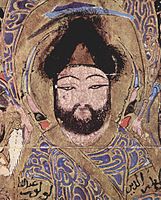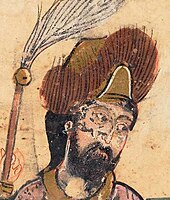샤르부시
Sharbūsh
샤르부시 또는 하부시(, 그리스어: σα ρπούζιν, 아랍어: sharbush)는 중세의 중앙 아시아와 중동에서 착용했던 특수한 튀르크 군용 털모자입니다. 그것은 바드르 알 딘 루루를 묘사한 미니어처 (1234–1259 통치)에 두드러지게 나타납니다.[1] 그것은 군인 계급의 뻣뻣한 모자였고, 삼각형 모양의 앞면에 때때로 금속판이 덧대어져 있었습니다. 그것은 때때로 작은 커치프로 보충되어 타크피파라는 이름의 작은 터번을 형성했습니다.[2] 샤르부시의 착용은 중세 중동 미니어처에서 투르크계 인물과 아랍계 인물을 구별하는 중요한 그래픽 요소 중 하나였습니다.[3]
샤르부시는 크기와 모양이 다양할 수 있으며, 알하리리의 1237년 마카마트 앞 조각에 있는 에미르를 묘사한 것처럼 때때로 엄청난 비율을 차지합니다.[3] 샤르부시의 모양은 지리적인 지역에 따라 다양한 것으로 보입니다.
- 아르투키드 필사본(예)의 샤부시는 머리판 뒤에 매우 높은 캡이 있고 테두리 주변의 모피 사용은 제한적입니다.[4]
- 페르시아의 도자기나, 블라카족과 같은 모술의 물건, 혹은 아지라와 시리아의 필사본에서 볼 수 있는 셀주크 샤르부시는 훨씬 낮은 모자를 가지고 있었고, 머리와 앞판을 둘러싸고 있는 모피 뒤에 거의 숨겨져 있었습니다.[4]
- 바그다드 쉐퍼 마하마트의 앞 부분은 모자를 시야에서 숨기고 있는 키가 큰 털 덩어리로 구성된 또 다른 날카로운 덤불을 보여줍니다.[4]
맘루크 이집트에서는 1382년 샤르부시 착용이 금지되었습니다.[5][6]
- 아르투키드 샤부시, 1206 (Ms. Ahmet III 3472)
- 마카마트 알하리리(BNF Arabe 3929, 1200년경-1210년경), 키 큰 모자와 함께 샤브부시를 착용한 터키 통치자 세부 사항
참고문헌
- ^ Rice, D. S. (1953). "The Aghānī Miniatures and Religious Painting in Islam". The Burlington Magazine. 95 (601): 128–135. ISSN 0007-6287.
- ^ Yedida Kalfon Stillman, Norman A. Stillman (2003). Arab Dress: A Short History : from the Dawn of Islam to Modern Times. Leiden, Netherlands: Brill. p. 67. ISBN 9789004113732.
The normal headgear of the military class was a stiff cap with a triangular front which in some instances appears to have been a metallic plaque. It was sometimes trimmed with fur and was called a sharbUsh (see PI. 23 which depicts a Saljuq atabeg wearing a sharbUsh and tiriiz qabii' and also PI. 19), and sometimes it had a small kerchief bound around it to form a sort of turban which was designated a takhfifa. The sharbush was absolutely de rigueur for an amir.
- ^ a b c d Contadini, Anna (2012). A world of beasts: a thirteenth-century illustrated Arabic book on animals (the Kitāb Na't al-Ḥayawān) in the Ibn Bakhtīshū' tradition. Leiden Boston: Brill. p. 127. ISBN 978-90-04-20100-2.
Reference has already been made to the combination of boots and sharbūsh as markers of official status (...) the combination is standard, even being reflected in thirteenth-century Coptic paintings, and serves to distinguish, in Grabar's formulation, the world of the Turkish ruler and that of the Arab. (...) The type worn by the official figures in the 1237 Maqāmāt, depicted, for example, on fol. 59r,67 consists of a gold cap surmounted by a little round top and with fur trimming creating a triangular area at the front which either shows the gold cap or is a separate plaque. A particular imposing example in this manuscript is the massive sharbūsh with much more fur than usual that is worn by the princely official on the right frontispiece on fol. 1v.
- ^ a b c Ward, Rachel (1 January 1985). "Evidence for a School of Painting at the Artuqid Court". Oxfod Studies in Islamic Art, vol. 1, pp. 69-83: 77.
- ^ Yedida Kalfon Stillman, Norman A. Stillman (2003). Arab Dress: A Short History : from the Dawn of Islam to Modern Times. Leiden, Netherlands: Brill. p. 67. ISBN 9789004113732.
- ^ Nicholas, Nick; Baloglou, George (2003), An Entertaining Tale of Quadrupeds: Translation and Commentary, Columbia University Press, p. 63, ISBN 9780231127608
- ^ Hillenbrand 2010, 페이지 118, 노트 10. CITEREF 2010 (
- ^ Contadini, Anna (2012). A world of beasts: a thirteenth-century illustrated Arabic book on animals (the Kitāb Na't al-Ḥayawān) in the Ibn Bakhtīshū' tradition. Leiden Boston: Brill. p. 127. ISBN 978-90-04-20100-2.
Reference has already been made to the combination of boots and sharbūsh as markers of official status (...) the combination is standard, even being reflected in thirteenth-century Coptic paintings, and serves to distinguish, in Grabar's formulation, the world of the Turkish ruler and that of the Arab. (...) The type worn by the official figures in the 1237 Maqāmāt, depicted, for example, on fol. 59r,67 consists of a gold cap surmounted by a little round top and with fur trimming creating a triangular area at the front which either shows the gold cap or is a separate plaque. A particular imposing example in this manuscript is the massive sharbūsh with much more fur than usual that is worn by the princely official on the right frontispiece on fol. 1v. (...) These are of yet another type and are identical to those on the official on the left holding a spear in the painting of the "Purple Betony" in the 1224 Dioscorides (Fig. 65b)
![Right frontispiece: ruler in Turkic dress (long braids, large Sharbush fur hat, boots, fitting coat), in the Maqamat of al-Hariri, 1237 CE, probably Baghdad.[3]](http://upload.wikimedia.org/wikipedia/commons/thumb/a/a6/Maqamat_al-Hariri_1237%2C_Turkic_Emir_portrait.jpg/160px-Maqamat_al-Hariri_1237%2C_Turkic_Emir_portrait.jpg)
![Turkic amir with guards, wearing the Turkic headgear Sharbush, in the preaching scene at Rayy in maqāma 21 (fols. 58v–59r), Maqamat of al-Hariri, 1237.[7][3]](http://upload.wikimedia.org/wikipedia/commons/thumb/2/2b/Turkic_guard_in_Preaching_scene_at_Rayy_in_maq%C4%81ma_21_%28fols._58v%E2%80%9359r%2C_douvle-page_spread_as_a_unit%29%2C_Maqamat_al-Harari_1237.jpg/200px-Turkic_guard_in_Preaching_scene_at_Rayy_in_maq%C4%81ma_21_%28fols._58v%E2%80%9359r%2C_douvle-page_spread_as_a_unit%29%2C_Maqamat_al-Harari_1237.jpg)
![Warrior in Turkic attire, wearing the Turkic headgear sharbush, De Materia Medica of Dioscorides, Iraq, 1224. Harvard Art Museums.[8]](http://upload.wikimedia.org/wikipedia/commons/thumb/b/b2/Warrior_with_the_Plant_Kestron%2C_De_Materia_Medica_of_Dioscorides%2C_Iraq_1224._Harvard_Art_Museums.jpg/108px-Warrior_with_the_Plant_Kestron%2C_De_Materia_Medica_of_Dioscorides%2C_Iraq_1224._Harvard_Art_Museums.jpg)






